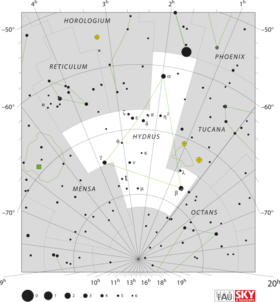Astronomy:Nu Hydri
| Observation data Equinox J2000.0]] (ICRS) | |
|---|---|
| Constellation | Hydrus |
| Right ascension | 02h 50m 28.45915s[1] |
| Declination | −75° 04′ 00.9969″[1] |
| Apparent magnitude (V) | 4.76[2] |
| Characteristics | |
| Spectral type | K3III[3] |
| U−B color index | +1.56[4] |
| B−V color index | +1.33[4] |
| Astrometry | |
| Radial velocity (Rv) | +3.09±0.16[1] km/s |
| Proper motion (μ) | RA: −33.392[1] mas/yr Dec.: −27.286[1] mas/yr |
| Parallax (π) | 9.8538 ± 0.1433[1] mas |
| Distance | 331 ± 5 ly (101 ± 1 pc) |
| Absolute magnitude (MV) | −0.33[2] |
| Details | |
| Mass | 3.5[5] or 1.79[6] M☉ |
| Radius | 21.23+3.23 −4.50[1] R☉ |
| Luminosity | 183.8±3.2[1] L☉ |
| Surface gravity (log g) | 3.30[7] cgs |
| Temperature | 4,612+584 −315[1] K |
| Metallicity [Fe/H] | −1.52[7] dex |
| Rotation | 50 d[5] |
| Rotational velocity (v sin i) | 1.3[8] km/s |
| Age | 2.38[6] Gyr |
| Other designations | |
| Database references | |
| SIMBAD | data |
ν Hydri, Latinized as Nu Hydri, is a single[10] star in the southern circumpolar constellation of Hydrus. It is orange-hued and faintly visible to the naked eye with an apparent visual magnitude of 4.76.[2] This object is located approximately 331 light years from the Sun based on parallax, and is drifting further away with a radial velocity of +3 km/s.[1] It is a member of the Ursa Major Moving Group of stars that share a common motion through space.[11]
This is an aging giant star with a stellar classification of K3III.[3] With the supply of hydrogen at its core exhausted, the star has expanded and cooled. At present it has 21[1] times the girth of the Sun. It is 2.4[6] billion years old with estimates of its mass ranging from 1.8[6] to 3.5[5] times the mass of the Sun. The star is radiating 184[1] times the Sun's luminosity from its swollen photosphere at an effective temperature of 4,612 K.[1]
References
- ↑ 1.00 1.01 1.02 1.03 1.04 1.05 1.06 1.07 1.08 1.09 1.10 1.11 1.12 Brown, A. G. A. (August 2018). "Gaia Data Release 2: Summary of the contents and survey properties". Astronomy & Astrophysics 616: A1. doi:10.1051/0004-6361/201833051. Bibcode: 2018A&A...616A...1G. Gaia DR2 record for this source at VizieR.
- ↑ 2.0 2.1 2.2 Anderson, E.; Francis, Ch. (2012). "XHIP: An extended hipparcos compilation". Astronomy Letters 38 (5): 331. doi:10.1134/S1063773712050015. Bibcode: 2012AstL...38..331A. Vizier catalog entry
- ↑ 3.0 3.1 Houk, Nancy (1978), Michigan catalogue of two-dimensional spectral types for the HD stars, 1, Ann Arbor: Dept. of Astronomy, University of Michigan, Bibcode: 1975mcts.book.....H
- ↑ 4.0 4.1 Mallama, A. (2014). "Sloan Magnitudes for the Brightest Stars". The Journal of the American Association of Variable Star Observers 42 (2): 443. Bibcode: 2014JAVSO..42..443M.Vizier catalog entry
- ↑ 5.0 5.1 5.2 Gondoin, P. (December 2005), "The relation between X-ray activity and rotation in intermediate-mass G giants", Astronomy and Astrophysics 444 (2): 531–538, doi:10.1051/0004-6361:20053567, Bibcode: 2005A&A...444..531G.
- ↑ 6.0 6.1 6.2 6.3 Luck, R. Earle (2015). "Abundances in the Local Region. I. G and K Giants". The Astronomical Journal 150 (3): 88. doi:10.1088/0004-6256/150/3/88. Bibcode: 2015AJ....150...88L.
- ↑ 7.0 7.1 Soubiran, Caroline; Le Campion, Jean-François; Brouillet, Nathalie; Chemin, Laurent (2016). "The PASTEL catalogue: 2016 version". Astronomy & Astrophysics 591: A118. doi:10.1051/0004-6361/201628497. Bibcode: 2016A&A...591A.118S.
- ↑ De Medeiros, J. R.; Alves, S.; Udry, S.; Andersen, J.; Nordström, B.; Mayor, M. (2014). "A catalog of rotational and radial velocities for evolved stars". Astronomy & Astrophysics 561: A126. doi:10.1051/0004-6361/201220762. Bibcode: 2014A&A...561A.126D. Vizier catalog entry
- ↑ "nu Hyi". SIMBAD. Centre de données astronomiques de Strasbourg. http://simbad.u-strasbg.fr/simbad/sim-basic?Ident=nu+Hyi.
- ↑ Eggleton, P. P.; Tokovinin, A. A. (September 2008). "A catalogue of multiplicity among bright stellar systems". Monthly Notices of the Royal Astronomical Society 389 (2): 869–879. doi:10.1111/j.1365-2966.2008.13596.x. Bibcode: 2008MNRAS.389..869E.
- ↑ Chupina, N. V. et al. (June 2006), "Kinematic structure of the corona of the Ursa Major flow found using proper motions and radial velocities of single stars", Astronomy and Astrophysics 451 (3): 909–916, doi:10.1051/0004-6361:20054009, Bibcode: 2006A&A...451..909C.
 |


